
05/05/2008
Movies Home / Entertainment Channel / Bullz-Eye Home
He's never played a superhero before, of course, but Robert Downey, Jr. may very well have been the perfect choice to play the suave-yet- psychologically-conflicted, alcoholic billionaire industrialist Tony Stark, a.k.a, "Iron Man." Downey has built his reputation playing guys who are as charming and brilliant as they are neurotic, morally ambiguous (and often substance dependent). Who says a superhero can't be all these things?
Despite decades of acclaim, including his universally celebrated, one and only Oscar-nominated performance in "Chaplin," and his newfound A-list cred, Downey is still somewhat underrated, probably because, up to now, he has the good taste to appear mainly in the kind of films that tend to be a little too interesting, and a little too much fun, to become monster hits or massive Oscar winners. Unfortunately, that means that a lot of Downey's best work remains unseen by most people, but we can do something about that.
"Back to School" (1986)
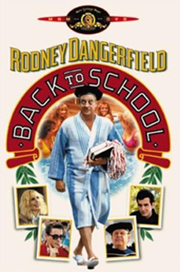 Downey doesn't have all that big a part in this good-natured 1986 comedy vehicle for one-liner king Rodney Dangerfield. Downey's work here is solid but not all that special compared to his later performances. Still, something about his appearance here caught the attention of critics and attentive audience members at the time, and it's easy to see why. As the zany, flamboyant (that's code for "probably gay") roommate of Dangerfield's down-to-earth son (Keith Gordon), Downey is mainly called to mug, make funny noises, and generally act as silly as possible during the film. It could easily have been an embarrassing, thankless role, but Downey milks it for what it's worth and proves he's confident enough to do just about anything. In one moment, trying vainly to cheer up a depressed Gordon (who wound up directing Downey in 2003's "The Singing Detective"), he lies supine and spreads his legs in one of the most pornographically homosexual, if fully clothed, moments in any mainstream American film. By the end, however, he does get a moment or two of quasi-sincerity in a scene with Burt Young ("Rocky") as Dangerfield's lovably surly chauffeur. Everyone's got to start somewhere.
Downey doesn't have all that big a part in this good-natured 1986 comedy vehicle for one-liner king Rodney Dangerfield. Downey's work here is solid but not all that special compared to his later performances. Still, something about his appearance here caught the attention of critics and attentive audience members at the time, and it's easy to see why. As the zany, flamboyant (that's code for "probably gay") roommate of Dangerfield's down-to-earth son (Keith Gordon), Downey is mainly called to mug, make funny noises, and generally act as silly as possible during the film. It could easily have been an embarrassing, thankless role, but Downey milks it for what it's worth and proves he's confident enough to do just about anything. In one moment, trying vainly to cheer up a depressed Gordon (who wound up directing Downey in 2003's "The Singing Detective"), he lies supine and spreads his legs in one of the most pornographically homosexual, if fully clothed, moments in any mainstream American film. By the end, however, he does get a moment or two of quasi-sincerity in a scene with Burt Young ("Rocky") as Dangerfield's lovably surly chauffeur. Everyone's got to start somewhere.
"Less Than Zero" (1987)
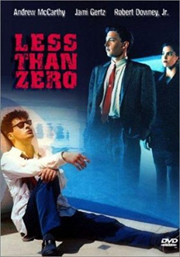 If it weren't for Downey, there wouldn't be much reason to see this ludicrously tame, severely cleaned-up 1987 adaptation of literary brat-packer Brett Easton Ellis's notorious first novel, a mid-'80s sensation for its depiction of druggy, multisexual youthful decadence among L.A.'s most lavishly spoiled youngsters. In his breakthrough role, third-billed Downey (who is saddled with some less than spectacular scene-partners in costars Andrew McCarthy and Jami Gertz) brings two elements that would otherwise be entirely lacking from the book and the film: humor and humanity. Of course, the severely addicted, downward spiraling Julian obviously shared all too many aspects in common with Downey's real life, circa-1987, and there are several scenes where Downey's depiction of the ravages of cocaine and various pills and alcohol feels all too real. We're not suggesting that Downey was actually high during the making of the film – in a funny way we're kind of sure he wasn't. His performance is too effective, too well thought out for that to be the case. It's just as close to the real thing as it needs to be.
If it weren't for Downey, there wouldn't be much reason to see this ludicrously tame, severely cleaned-up 1987 adaptation of literary brat-packer Brett Easton Ellis's notorious first novel, a mid-'80s sensation for its depiction of druggy, multisexual youthful decadence among L.A.'s most lavishly spoiled youngsters. In his breakthrough role, third-billed Downey (who is saddled with some less than spectacular scene-partners in costars Andrew McCarthy and Jami Gertz) brings two elements that would otherwise be entirely lacking from the book and the film: humor and humanity. Of course, the severely addicted, downward spiraling Julian obviously shared all too many aspects in common with Downey's real life, circa-1987, and there are several scenes where Downey's depiction of the ravages of cocaine and various pills and alcohol feels all too real. We're not suggesting that Downey was actually high during the making of the film – in a funny way we're kind of sure he wasn't. His performance is too effective, too well thought out for that to be the case. It's just as close to the real thing as it needs to be.
"Natural Born Killers" (1994)
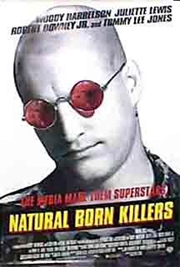 In this ultimate bad acid trip of an ultraviolent satire from 1994, Downey shows that no one does over-the-top dysfunction better. Sporting a hilarious, spot-on Aussie accent, Downey portrays Wayne Gale, host of "American Maniacs" – a sort of murder-obsessed Geraldo Rivera hot on the trail of ultimate thrill-killers Mickey and Mallory Knox (Woody Harrelson and Juliette Lewis). Though Gale isn't as overtly reprehensible as Tommy Lee Jones' cartoonishly depraved jail warden, or Tom Sizemore's murderous, attention-seeking Detective Scagnetti, he emerges as perhaps the film's true villain while simultaneously being the only character the audience might even consider empathizing with. In Downey's capable hand (the other one gets a giant bullet hole through the center), a rather ham-fisted strategy of implicating the audience into the bloody events onscreen (we paid money to see this, so the violence is our fault) is elevated through the very real respect Downey allows his deplorable media ambulance chaser. He portrays his character's voyeurism, greed, fear, duplicity and bloodlust as the ordinary human emotions they are, never allowing the audience to look down at Gale – even if the hack reporter's actual favorite emotion is self-pity. Sure, the guy is low, cowardly, and digs real-life violence, but he is also us. Downey doesn't let us forget that, but that's okay because, like Mickey and Mallory, we halfway like the guy.
In this ultimate bad acid trip of an ultraviolent satire from 1994, Downey shows that no one does over-the-top dysfunction better. Sporting a hilarious, spot-on Aussie accent, Downey portrays Wayne Gale, host of "American Maniacs" – a sort of murder-obsessed Geraldo Rivera hot on the trail of ultimate thrill-killers Mickey and Mallory Knox (Woody Harrelson and Juliette Lewis). Though Gale isn't as overtly reprehensible as Tommy Lee Jones' cartoonishly depraved jail warden, or Tom Sizemore's murderous, attention-seeking Detective Scagnetti, he emerges as perhaps the film's true villain while simultaneously being the only character the audience might even consider empathizing with. In Downey's capable hand (the other one gets a giant bullet hole through the center), a rather ham-fisted strategy of implicating the audience into the bloody events onscreen (we paid money to see this, so the violence is our fault) is elevated through the very real respect Downey allows his deplorable media ambulance chaser. He portrays his character's voyeurism, greed, fear, duplicity and bloodlust as the ordinary human emotions they are, never allowing the audience to look down at Gale – even if the hack reporter's actual favorite emotion is self-pity. Sure, the guy is low, cowardly, and digs real-life violence, but he is also us. Downey doesn't let us forget that, but that's okay because, like Mickey and Mallory, we halfway like the guy.
"Two Girls and a Guy" (1997)
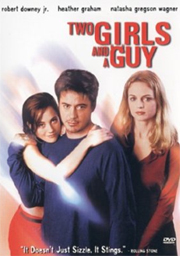 Downey's first starring role was in 1987's "The Pick-Up Artist," a widely disliked romantic comedy costarring '80s teen superstar Molly Ringwald. A decade later, that film's writer and director, James Toback ("Bugsy"), saw Downey on television after one of his drug arrests, and something about the actor's appearance inspired him to write the screenplay for this film in the space of a single week. It resulted in perhaps the ultimate vehicle for Downey's performing skills. Portraying a two-timing singer-actor ambushed by his furious girlfriends (Heather Graham and Natasha Gregson Wagner), Downey not only gets to verbally spar with his indignant attackers, parrying their verbal volleys and attempting to turn the emotional tables by spinning out truth and lies with such abandon that the two become indistinguishable, he also gets to sing classical music in a ridiculous falsetto, and popular music, well, not at all badly. (Downey's voice can also be heard in "The Singing Detective" and a 2004 CD, "The Futurist.") He also performs a brief, and somewhat amazing, reading from "Hamlet" and a rather beautiful piece of his own composition on piano during the film's affecting conclusion. One of the most relaxed, yet theatrical, tour de force performances in recent years, his performance proves two things: (1) Robert Downey, Jr. can do pretty much anything when it comes to performing, and (2) Robert Downey, Jr. can make just about any creep really likable.
Downey's first starring role was in 1987's "The Pick-Up Artist," a widely disliked romantic comedy costarring '80s teen superstar Molly Ringwald. A decade later, that film's writer and director, James Toback ("Bugsy"), saw Downey on television after one of his drug arrests, and something about the actor's appearance inspired him to write the screenplay for this film in the space of a single week. It resulted in perhaps the ultimate vehicle for Downey's performing skills. Portraying a two-timing singer-actor ambushed by his furious girlfriends (Heather Graham and Natasha Gregson Wagner), Downey not only gets to verbally spar with his indignant attackers, parrying their verbal volleys and attempting to turn the emotional tables by spinning out truth and lies with such abandon that the two become indistinguishable, he also gets to sing classical music in a ridiculous falsetto, and popular music, well, not at all badly. (Downey's voice can also be heard in "The Singing Detective" and a 2004 CD, "The Futurist.") He also performs a brief, and somewhat amazing, reading from "Hamlet" and a rather beautiful piece of his own composition on piano during the film's affecting conclusion. One of the most relaxed, yet theatrical, tour de force performances in recent years, his performance proves two things: (1) Robert Downey, Jr. can do pretty much anything when it comes to performing, and (2) Robert Downey, Jr. can make just about any creep really likable.
"Wonder Boys" (2000)
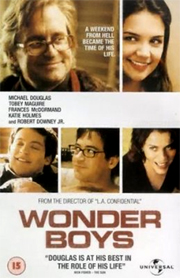 Despite the fact that he's first seen in the company of a six-foot-plus transvestite, for once Downey's character is not the most eccentric character in a major Hollywood film. While literary editor Terry Crabtree still has the bad little boy smirk common to all Downey characters, his own issues are downright mild compared to Michael Douglas' Grady Tripp, a 50-year-old professor, semi-professional pot-smoker, and neurotically stricken one-hit-wonder novelist, as well as Tobey Maguire's James Leer, an emotionally constricted budding author and semi-pathological liar. The fact that Terry has a serious case of the hots for young Leer garners a few snickers, but not only of the homophobic variety – Downey's indescribable repetition of his new beloved's name – "Jimmy, Jimmy, Jimmy" – is a hilarious touch that shows both his character's horniness and growing affection for the younger writer. A great supporting performance in every sense of the word, this is also one of Downey's most subdued roles, but it is no less worth seeing, and one of many reasons that writer Steve Kloves and director Curtis Hanson's 2000 adaptation of a novel by Michael Chabon is one of the two or three best films Downey's been seen in.
Despite the fact that he's first seen in the company of a six-foot-plus transvestite, for once Downey's character is not the most eccentric character in a major Hollywood film. While literary editor Terry Crabtree still has the bad little boy smirk common to all Downey characters, his own issues are downright mild compared to Michael Douglas' Grady Tripp, a 50-year-old professor, semi-professional pot-smoker, and neurotically stricken one-hit-wonder novelist, as well as Tobey Maguire's James Leer, an emotionally constricted budding author and semi-pathological liar. The fact that Terry has a serious case of the hots for young Leer garners a few snickers, but not only of the homophobic variety – Downey's indescribable repetition of his new beloved's name – "Jimmy, Jimmy, Jimmy" – is a hilarious touch that shows both his character's horniness and growing affection for the younger writer. A great supporting performance in every sense of the word, this is also one of Downey's most subdued roles, but it is no less worth seeing, and one of many reasons that writer Steve Kloves and director Curtis Hanson's 2000 adaptation of a novel by Michael Chabon is one of the two or three best films Downey's been seen in.
"A Scanner Darkly" (2006)
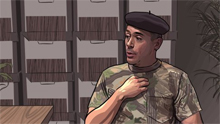 One of the most impressive aspects of Downey's work is how, even in taking roles that seem very much like "classic" Downey roles, his work never feels clichéd, self-parodying, or anything less than completely fresh. Richard Linklater's rotoscoped 2006 adaptation of Phillip K. Dick's science fiction classic of drug addiction in the near future features Downey as James Barris. Barris might not have been the calmest or nicest guy to begin with but, under the constant influence of the pernicious, super-addictive designer drug, Substance D, he is a collection of amusingly annoying ticks, probably a borderline sociopath, and a bit of a geek. Downey makes this not-quite villain an almost likable character we can't take our eyes off of – even if Linklater's trippy animation is rendering his face into some pretty strange contortions. A particularly chilling scene has Barris hanging out with fellow junkie Ernie Luckman (Woody Harrelson), who starts to choke to death on a piece of food as Barris calmly dawdles, seemingly unsure whether or not the immanent death of a companion is something he should seriously concern himself with. When Luckman finally is able to recover on his own, Barris responds to Luckman's anger with the kind of hilariously twisted invective a lesser actor would gag on, yet Downey delivers the lines as if he's just thinking of them right now. It's what he does.
One of the most impressive aspects of Downey's work is how, even in taking roles that seem very much like "classic" Downey roles, his work never feels clichéd, self-parodying, or anything less than completely fresh. Richard Linklater's rotoscoped 2006 adaptation of Phillip K. Dick's science fiction classic of drug addiction in the near future features Downey as James Barris. Barris might not have been the calmest or nicest guy to begin with but, under the constant influence of the pernicious, super-addictive designer drug, Substance D, he is a collection of amusingly annoying ticks, probably a borderline sociopath, and a bit of a geek. Downey makes this not-quite villain an almost likable character we can't take our eyes off of – even if Linklater's trippy animation is rendering his face into some pretty strange contortions. A particularly chilling scene has Barris hanging out with fellow junkie Ernie Luckman (Woody Harrelson), who starts to choke to death on a piece of food as Barris calmly dawdles, seemingly unsure whether or not the immanent death of a companion is something he should seriously concern himself with. When Luckman finally is able to recover on his own, Barris responds to Luckman's anger with the kind of hilariously twisted invective a lesser actor would gag on, yet Downey delivers the lines as if he's just thinking of them right now. It's what he does.
"Zodiac" (2007)
 David Fincher's epic 2007 film about the still-unsolved serial killings that plagued Northern California during the late '60s was a strong favorite with critics and cinephiles, but the lengthy, decades-spanning tale of un-resolvable obsession was perhaps a bit much for a general audience. Still, Downey's drug-and-alcohol soaked supporting role as real life journalist Paul Avery is a quintessential Downey performance, full of hilarious ticks and genuine emotion as the prickly, troubled journalist slowly warms to eager-beaver political cartoonist, amateur cryptologist, and overgrown Eagle Scout Robert Graysmith (Jake Gyllenhaal), as the two become increasingly involved in attempts to track down the elusive murderer. A scene in a bar in which Graysmith introduces Avery to a suspiciously girly-looking turquoise blue cocktail called an Aqua Velva is a moment few other actors could improve on. Avery examines the drink suspiciously, eyes darting around the room to make sure no one's watching, and finally takes a cautious, but large, gulp. It's a perfect set-up to the predictable, but actually funny, joke of the next cut – a tipsy Gyllenhaal and Downey surrounded by several mostly downed Aqua Velvas. Once again, Downey sets up a crucial moment of comic relief, which also speaks volumes about his character and the wary bond he is building with his unlikely new partner.
David Fincher's epic 2007 film about the still-unsolved serial killings that plagued Northern California during the late '60s was a strong favorite with critics and cinephiles, but the lengthy, decades-spanning tale of un-resolvable obsession was perhaps a bit much for a general audience. Still, Downey's drug-and-alcohol soaked supporting role as real life journalist Paul Avery is a quintessential Downey performance, full of hilarious ticks and genuine emotion as the prickly, troubled journalist slowly warms to eager-beaver political cartoonist, amateur cryptologist, and overgrown Eagle Scout Robert Graysmith (Jake Gyllenhaal), as the two become increasingly involved in attempts to track down the elusive murderer. A scene in a bar in which Graysmith introduces Avery to a suspiciously girly-looking turquoise blue cocktail called an Aqua Velva is a moment few other actors could improve on. Avery examines the drink suspiciously, eyes darting around the room to make sure no one's watching, and finally takes a cautious, but large, gulp. It's a perfect set-up to the predictable, but actually funny, joke of the next cut – a tipsy Gyllenhaal and Downey surrounded by several mostly downed Aqua Velvas. Once again, Downey sets up a crucial moment of comic relief, which also speaks volumes about his character and the wary bond he is building with his unlikely new partner.
You can follow us on Twitter and Facebook for content updates. Also, sign up for our email list for weekly updates and check us out on Google+ as well.











